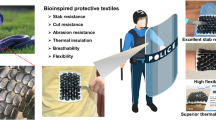Abstract
The glue-coated and wet capture spiral of the orb web of the garden cross spider Araneus diadematus is suspended between the dry silk radial and web frame threads. Here, we experimentally demonstrate that the capture spiral is electrically conductive because of necks of liquid connecting the droplets even if the thread is stretched. We examine how this conductivity of the capture spiral may lead to entrapment of charged airborne particles such as pollen, spray droplets and even insects. We further describe and model how the conducting spiral will also locally distort the Earth's ambient electric field. Finally, we examine the hypothesis that such distortion could be used by potential prey to detect the presence of a web but conclude that any effect would probably be too small to allow an insect to take evasive action.




Similar content being viewed by others
References
Bleaney BL, Bleaney B (1989) Electricity and magnetism. 3rd edn. Oxford University Press, Oxford, pp 18–20 and 48–51
Clarke D, Whitney H, Sutton G, Robert D (2013) Detection and learning of floral fields by bumblebees. Science 340:66–69
Dyer SA (2004) Wiley survey of instrumentation and measurement. Wiley, New York
Edmonds DT, Vollrath F (1992) The contribution of atmospheric water vapour to the formation and efficiency of a spider's capture web. Proc R Soc Lond B 248:145–148
Es'kov EK, Sapozhnikov AM (1976) Mechanisms of generation and perception of electric fields by honey bees. Biofizika 21:1097–1102
Feynman RP, Leighton RB, Sands M (2013) The Feynman lectures on physics, desktop edition volume II: the new millennium edition. Basic Books, New York
Gott JP (1933) On the electric charge collected by water drops falling through ionized air in a vertical electric field. Proc R Soc Lond Ser A 142:248–268
Greggers U, Koch G, Schmidt V, Dürr A, Floriou-Servou A, Piepenbrock D, Göpfert M, Menzel R (2013) Reception and learning of electric fields by bees. Proc R Soc B 280:20130528. doi:10.1098/rspb.2013.0528
Jaworek A, Adamiak K, Krupa A (1998) 3D model for trajectories of airborne particles near a charged spherical collector. pp 1–8, 3rd international conference on multiphase flow, ICMF-98 Lyon, June 8–12, 1998
Köhler T, Vollrath F (1995) Thread biomechanics in the two orb weaving spiders Araneus diadematus (Araneae, Araneidae) and Uloborus walckenaerius (Araneae, Uloboridae). J Exp Zool 271:1–17
Opell BD, Markley BJ, Hannum CD, Hendricks ML (2008) The contribution of axial fiber extensibility to the adhesion of viscous capture, threads spun by orb-weaving spiders. J Exp Biol 211:2243–2251
Opell BD, Tran AM, Karinshak SE (2011) Adhesive compatibility of cribellar and viscous prey capture threads and its implication for the evolution of orb-weaving, spiders. J Exp Zool 315:376–384
Opell BD, Karinshak SE, Sigler MA (2011) Humidity affects the extensibility of an orb-weaving spider’s viscous thread droplets. J Exp Biology 214:2988–2993
Ortega-Jimenez VM, Dudley R (2013) Spiderweb deformation induced by electrostatically charged insects. Sci Rep 3:2108. doi:10.1038/srep02108
Rachold V, Heinrichs H (1992) Spinnweben: Natürliche Fänger atmospherisch transportierter Feinstäube. Naturwissenschaften 79:175–178
Richens DT (1997) The chemistry of aqua ions. Wiley, New York
Samu F, Matthews GA, Lake D, Vollrath F (1992) Spider webs are efficient collectors of agrochemical spray. Pestic Sci 36:47–51
Smythe WR (1989) Static and dynamic electricity, 3rd edn. Hemisphere, New York, pp 172–179
Vollrath F, Edmonds DT (1989) Modulation of the mechanical properties of spider silk by coating with water. Nature 340:305–307
Vollrath F, Tillinghast E (1991) Glycoprotein glue beneath a spider web's aqueous coat. Naturwissenschaften 78:557–559
Vollrath F, Fairbrother WJ, Williams RJP, Tillinghast EK, Bernstein DT, Gallager KS, Townley MA (1990) Compounds in the droplets of the orb spider's viscid spiral. Nature 345:526–528
Wan H, Wei G, Cui Y, Chen Y (2012) Influence factor analysis of atmospheric electric field monitoring near ground under different weather conditions, 7th international conference on applied electrostatics (ICAES-2012), Journal of Physics: Conference Series, 418, (2013) 012029, IOP Publishing
Warnke U (1976) Effects of electric charges on honey bees. Bee World 57(2):1–56
Xiao-li S, Yu P, Hose GC, Jian C, Feng-xiang L (2006) Spider webs as indicators of heavy metal pollution in air. Environ Contam Toxicol 76:271–277
Acknowledgments
We thank the Science and Engineering Research Council of the UK for funding the original study in 1985 and the Air Force Office of Scientific Research (FA9550-12-1-0294) and European Research Council (324607) for funding the recent follow-up analysis by FV. FV also thanks a patient editor, four excellent anonymous reviewers and Sebastien Neukirch for helpful comments. Donald Edmonds sadly passed away last year after a long illness.
Author information
Authors and Affiliations
Corresponding author
Additional information
Communicated by: Sven Thatje
Donald Edmonds is deceased.
Electronic supplementary material
Below is the link to the electronic supplementary material.
Legend: A section of Araneus diadematus capture thread is observed under a microscope seconds after it has been deposited in the web under RH of 55 %. The thread shows the swelling of the coating followed rapidly by the formation of individual droplets evenly spaced. (MP4 43026 kb)
Legend : Film showing the distortion of an orb web of Araneus diadematus by a metallic sphere of radius 5 mm charged to a voltage of 5 kV. In (a) the Voltage is positive and in (b) it is negative demonstrating that the neutral but electricity-conducting web is equally attracted to the charged sphere in both cases. (MP4 64550 kb)
Rights and permissions
About this article
Cite this article
Vollrath, F., Edmonds, D. Consequences of electrical conductivity in an orb spider's capture web. Naturwissenschaften 100, 1163–1169 (2013). https://doi.org/10.1007/s00114-013-1120-8
Received:
Revised:
Accepted:
Published:
Issue Date:
DOI: https://doi.org/10.1007/s00114-013-1120-8




